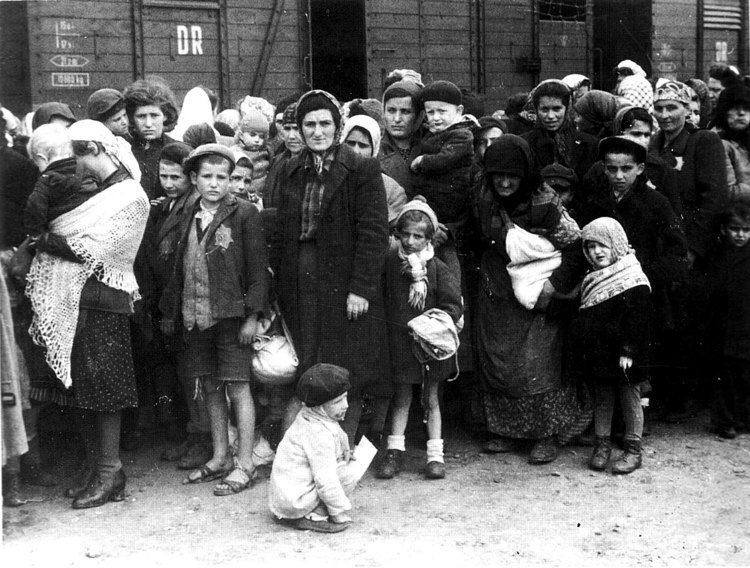Start date July 7, 1941 | ||
 | ||
The Wąsosz pogrom was the mass murder of Jewish residents of Wąsosz in Nazi German occupied Poland that took place on 5 July 1941, during World War II.
Contents
Circumstances surrounding the pogrom
When Nazi Germany invaded Poland in 1939, the village of Wąsosz (Podlaskie Voivodeship) was taken by the Germans in the second week of the war. At the end of September, in accordance with the German–Soviet Boundary Treaty, the area was transferred by the Nazis to the Soviet Union.
The Soviet Union invaded Poland from the East two weeks earlier, on 17 September 1939, pursuant to the secret protocol of the Molotov–Ribbentrop Pact. The Red Army overran 52.1% of territory of Poland with over 13,700,000 inhabitants. The Soviet occupation zone included 5.1 million ethnic Poles (ca. 38%), 37% Ukrainians, 14.5% Belarusians, 8.4% Jews, 0.9% Russians and 0.6% Germans. There were also 336,000 refugees who escaped to eastern Poland from areas already occupied by Germany – most of them Polish Jews numbering at around 198,000. Soon thereafter, the Soviet secret police began spreading terror throughout the region. Polish prisoners of war were massacred. In less than two years the Soviet NKVD conducted mass deportations of up to 1.5 million ethnic Poles to Siberia, with some of the local people collaborating with them, including some Jews who formed armed militias. There were also instances of Jewish Communists denouncing ethnic Poles to the Soviets.
Following the Nazi German invasion of the Soviet Union, German Wehrmacht re-entered Wąsosz on 22 June 1941. At that time, 800 Jews lived in the town according to the one and only one existing deposition.
The only existing document
The only account of what might have happened during the pogrom belongs to a document written by 22-year-old Menachem Finkielsztejn who had lived in the region with his parents under Polish protection during the Holocaust, before his subsequent emigration to Israel with his family and siblings. The paper, deposited in June 1945 at the Jewish Committee in Białystok, was a rough and unsigned translation from Yiddish, with original, attributed to Finkielsztejn. His own estimation of the number of Jews burned alive in a barn in nearby Jedwabne was over ten times higher than what has been established by the Institute of National Remembrance (IPN) as a fact. Exaggerated stories such as the one written by Finkielsztejn, were encouraged by CKŻP as possible backup for exit visas. They weren't utilized by CKŻP because of the free-passage decree issued by Gen. Spychalski. According to Finkielsztejn, the advancing German troops soon moved on leaving behind Nazi police presence. In the second week of the German occupation, a Polish militia was formed on the order of German gendarmerie. It consisted of "local thugs", wrote Finkielsztejn. On 5 July 1941 this unit surrounded Wąsosz to prevent Jews from escaping, and a house to house pogrom began. The actual description of the pogrom remains unverified to this day and, as noted by Polish and American scholars, it might have been rewritten by Jewish custodians of the original document.
As Finkielsztejn writes – on 6 July 1941 the Jews who escaped from Wąsosz arrived in the neighboring town of Radziłów, but the next day pogrom broke out there as well. According to his deposition 1,500 local and refugee Jews were burned there in a barn. However, there's also an early Polish monument on the outskirts of Radziłów which reads, "In August 1941 fascists murdered 800 persons of Jewish descent [undated], 500 of them were burned alive in a barn." The date on the monument is incorrect but historical research confirms that Jews were killed in Radziłów on 7 July how many, and under what circumstances, remains unknown. The pages from Finkielsztejn's paper describing the actual pogrom vanished from the Jewish Historical Institute of Warsaw in the following years. According to the remaining page, the Germans found later, that allegedly only fifteen Jews were left alive in Wąsosz. The Jews stayed in the town until June 1942 under the supervision of German gendarmerie who "behaved properly" (whatever it means); and were used by the Nazis for forced labor purposes. Finkielsztejn insisted that all criminals were Polish, even those who had Russian names, or were driving German tanks, while armed to their teeth by the Gestapo. His paper ends there. In November 1942 the survivors were moved to the Bogusze transit camp and in January 1943 sent to Majdanek or Treblinka extermination camps.
Investigation
The crimes committed in Wąsosz are being investigated by Institute of National Remembrance of Poland, under the direction of the IPN prosecutor Radosław Ignatiew who earlier investigated the atrocities in Jedwabne. Ignatiew pointed to the role of the Gestapo agent Mieczysław Kosmowski a.k.a. "Gienek" (born 1913) renamed Walter Krause and paid 250 Deutsche marks per month by the Gestapo for his denunciations of Poles and Jews in the Białystok region. The IPN chief prosecutor in Białystok, Zbigniew Kulikowski, named agent Kosmowski (last seen in Bydgoszcz in 1944), as the main instigator of the Nazi German raid on the Jewish community of Wąsosz.
According to Alexander B. Rossino, historian at the Washington Holocaust museum, the atrocities committed in Radziłów near Wąsosz were likely perpetrated by the Gestapo paramilitary Einsatzgruppe Zichenau-Schroettersburg under SS-Obersturmführer Hermann Schaper. The methods used by his death squad in Radziłów were identical to those employed in Jedwabne only three days later – as shown by the evidence collected in West Germany between 1964-1976.
